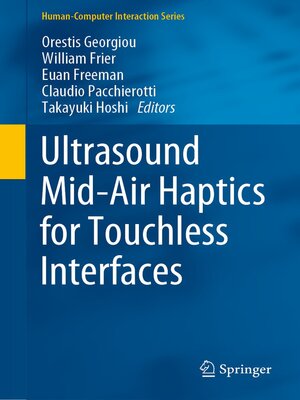Ultrasound Mid-Air Haptics for Touchless Interfaces
ebook ∣ Human–Computer Interaction Series
By Orestis Georgiou

Sign up to save your library
With an OverDrive account, you can save your favorite libraries for at-a-glance information about availability. Find out more about OverDrive accounts.
Find this title in Libby, the library reading app by OverDrive.



Search for a digital library with this title
Title found at these libraries:
| Library Name | Distance |
|---|---|
| Loading... |
Over the last decade, ultrasound mid-air haptic technology has emerged and rapidly advanced to engage multidisciplinary scientific communities within and adjacent to the haptics and HCI fields. Additionally, this haptic technology has been adopted by a number of industry sectors (e.g., automotive, virtual reality, digital signage, neuroscience research) who appear keen to exploit its unique value proposition: the ability to deliver rich haptic sensations from a distance, without the need to touch, wear or hold anything in order to enhance touchless interfaces, novel applications, and experiences.
This book is the first, and currently the only one, that provides a comprehensive description of the technology, encapsulating almost all aspects relating to electronic prototyping, acoustics, haptics, psychology and perception, user experience and end-user HCI applications. Through its 18 chapters written by 30 expert co-authors, this book is therefore an excellent introduction to the technology for anyone coming from any of those fields. Specifically, the reader will benefit by getting a unique and multi-dimensional perspective on the state-of-the-art of this enabling haptic technology while also understanding its history, relevant best research practices, and an overview of the various open challenges and opportunities.
This book is the first, and currently the only one, that provides a comprehensive description of the technology, encapsulating almost all aspects relating to electronic prototyping, acoustics, haptics, psychology and perception, user experience and end-user HCI applications. Through its 18 chapters written by 30 expert co-authors, this book is therefore an excellent introduction to the technology for anyone coming from any of those fields. Specifically, the reader will benefit by getting a unique and multi-dimensional perspective on the state-of-the-art of this enabling haptic technology while also understanding its history, relevant best research practices, and an overview of the various open challenges and opportunities.







